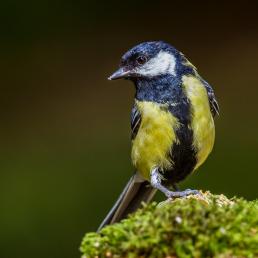

Join BirdNote tomorrow, November 30th!
Illustrator David Sibley and actor H. Jon Benjamin will face off in the bird illustration battle of the century during BirdNote's Year-end Celebration and Auction!
A Great Bustard shows off to a group of females by inflating special neck sacs – producing what sounds like a massive sneeze followed by a Bronx cheer. He flips his wings almost upside down to reveal bright white undersides, while fanning his tail and long, white throat whiskers. Three feet tall and weighing as much as forty pounds, a Great Bustard appears to walk with self-conscious dignity on long thick legs, like an Ostrich or Emu. Bustards are found in open landscapes across southern Europe, Africa, Asia, and Australia, where that impressive mating display can be seen and heard.
BirdNote®
Great Bustard – Europe’s Heavyweight Struts His Stuff
Written by Bob Sundstrom
This is BirdNote.
[Great Bustard male display sounds, https://www.youtube.com/watch?v=F7scfEj5Dt4&app=desktop]
A Great Bustard, the heavyweight champion of all European birds, is showing off to a group of females, strutting his stuff across an open field.
[Great Bustard male display sounds, https://www.youtube.com/watch?v=F7scfEj5Dt4&app=desktop]
The stylish male Great Bustard is feathered in gold and russet brown. In a display that rivals our own sage-grouse, he sounds off by inflating special neck sacs – producing what sounds like a massive sneeze followed by a Bronx cheer.
Simultaneously, he flips his wings almost upside down to reveal bright white undersides, while fanning his tail and long, white throat whiskers.
[Great Bustard male display sounds, https://www.youtube.com/watch?v=F7scfEj5Dt4&app=desktop]
Great Bustards are imposing birds – three feet tall and weighing up to forty pounds. They appear to walk with self-conscious dignity — head held high and with a confident stride on long, thick legs — reminiscent of an Ostrich or Emu. Unlike those two, however, the bustard is a strong flyer — rising into the air with powerful wing strokes. Mostly, though, they prefer to walk.
Their heritage dates back more than 70 million years. Today, bustards, 26 species in all, are found in open landscapes across southern Europe, Africa, Asia and Australia. Habitats where that impressive mating display can be heard— and seen — by females looking for a mate.
[Great Bustard male display sounds, https://www.youtube.com/watch?v=F7scfEj5Dt4&app=desktop]
For BirdNote.org, I’m Mary McCann.
###
Bird sounds provided by The Macaulay Library of Natural Sounds at the Cornell Lab of Ornithology, Ithaca, New York.
BirdNote’s theme music was composed and played by Nancy Rumbel and John Kessler.
Producer: John Kessler
Executive Producer: Sallie Bodie
© 2017 Tune In to Nature.org May 2017/2021 Narrator: Mary McCann
ID# GREBUS-01-2017-05-17 GREBUS-01
videos with sound: https://m.youtube.com/watch?v=Tg41jpg_wZQ,
https://m.youtube.com/watch?v=UCsJG3WMxBU
silent video: http://macaulaylibrary.org/video/455802.
another source: http://greatbustard.org/about-the-birds/







